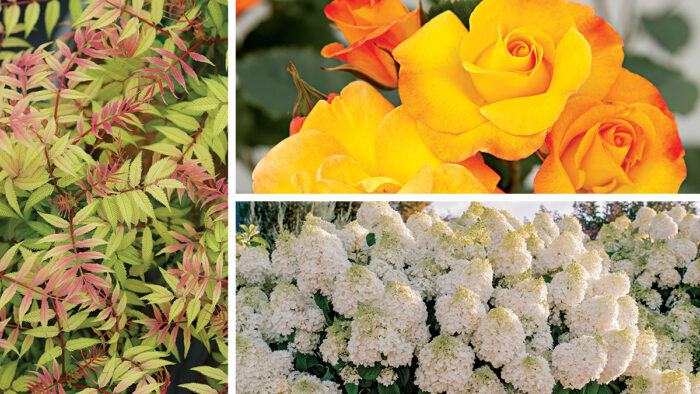
Each year we do a feature in our big spring issue introducing folks to a slew of new offerings from plant breeders. But this is not simply a list of plants that we think look interesting. Our standards here at Fine Gardening are higher. We interview breeders, marketers, and the heads of trial gardens across the country to dig deeper into why a particular new plant is worthy of praise. Below, you’ll find the best new trees and shrubs. Which new plants are right for you? Read on to find out.
Big blooms in a unique hue make it a must-have shrub

Beyond Pink’d™ bluebeard
Name: Caryopteris incana ‘DCARBEYBAR’
Zones: 6b–9
Size: 2 to 3 feet tall and wide
Conditions: Full sun; moist, well-drained soil
Native range: East Asia Bluebeard is a fall wonder shrub that every gardener drools over. This drought-tolerant plant is a hit with pollinators, especially because it puts on its show late in the season when not much else is flowering. Beyond Pink’d offers bigger blooms and in a rosy hue (instead of the standard blue) not commonly seen in autumn. The compact habit makes it suitable for virtually any size space.
Introduced by: Proven Winners® Color Choice®
These vibrant blooms won’t wash out in full sun

Fiesta Veranda® rose
Name: Rosa ‘Korhesanwes’
Zones: 5–11
Size: 3 to 4 feet tall and 2 to 3 feet wide
Conditions: Full sun; moist, well-drained soil
Native range: Hybrid
Yellow roses are a quintessential summer flower. They evoke thoughts of warm, sunny days without even trying. But if you’ve ever grown a yellow rose, you know that in direct sun (which roses need) the blooms can bleach out to a dingy cornmeal color. This is not the case with Fiesta Veranda rose, whose rich golden hue stays true, even in prolonged sunlight.
Introduced by: Star® Roses and Plants
Amazing spring color gives way to an impressive flower show

Mr. Mustard™ false spirea
Name: Sorbaria sorbifolia* ‘SMNSSC’
Zones: 2–7
Size: 2 to 3 feet tall and 3 to 4 feet wide
Conditions: Full sun to partial shade; moist, well-drained soil
Native range: Temperate areas of Asia
Don’t be alarmed. This false spirea is more easily managed than most. Mr. Mustard™ will sucker, but with some selective trimming you’ll be able to keep it in check. And a little extra effort is worth it for the incredible yellow, red, and chartreuse growth that appears in spring. That will slowly fade to a bright green just in time to set the stage for giant plumes of white cotton candy–like blooms that pollinators adore. The foliage texture is pretty lovely as well.
Introduced by: Proven Winners® Color Choice®
Expect glowing foliage in every season

Touch of Gold® Japanese holly
Name: Ilex crenata ‘Adorned’
Zones: 6–9
Size: 2 feet tall and 4 feet wide
Conditions: Full sun to partial shade; moist, well-drained soil
Native range: Japan, Korea, China, eastern Russia
Around here we love the look of variegated boxwoods (Buxus spp. and cvs., Zones 4–9). But with boxwood blight sweeping across the country, they’re not always a smart choice. Japanese holly offers a similar look to boxwood, but without all the pest and disease issues. This new golden variegated form is especially stunning as a foundation plant or in a mixed border. And we can’t wait to take clippings of it for our holiday decorations.
Introduced by: Southern Living® Plant Collection
Buying tip: Don’t be afraid to purchase bareroot trees and shrubs. Many mail-order companies prefer to send larger plants in this way since it cuts down on shipping costs, and when done right, it causes less stress on the plant. Just be sure to check out proper bareroot planting techniques.
Put this hydrangea in hot, dry conditions, and watch it thrive

Little Hottie® panicle hydrangea
Name: Hydrangea paniculata ‘Bailpanone’
Zones: 4–8
Size: 3 to 5 feet tall and wide
Conditions: Full sun to partial shade; moist, well-drained soil
Native range: China, Japan
It’s not just the South and West that deal with periods of hot, dry weather anymore. Two years ago the Northeast suffered a terrible drought, and with it many plants that were once thought of as indestructible, like panicle hydrangeas, died. Panicle hydrangeas are known as tough, but Little Hottie takes that to the next level. It was bred to thrive in hot, dry conditions without skipping a beat. And you don’t need to sacrifice any flower power for all that toughness. No matter the punishing conditions, there will be blooms galore.
Introduced by: Bailey Nurseries
Its interesting variegated display doesn’t quit

Vanilla Brandy™ abelia
Name: Abelia × grandiflora ‘Balibeliaone’
Zones: 6–9
Size: 2 to 3 feet tall and wide
Conditions: Full sun to partial shade; moist, well-drained soil
Native range: Hybrid
This shrub puts on a foliage show like very few others. In spring the green leaves emerge with a generous white margin. In fact, from a distance, this abelia looks white. Then in summer, ivory-pink flowers pop out, and their tubular shape attracts hummingbirds from afar. Finally, in fall when temperatures begin to cool, the foliage blushes with a rose hue. The result is a shrub that keeps getting better as the season progresses.
Introduced by: Bailey Nurseries
*Invasive alert:
False spirea (Sorbaria sorbifolia)
This plant is considered invasive in AK and NH.
Please visit invasiveplantatlas.org for more information.
Fine Gardening Recommended Products

DeWalt Variable-Speed Cordless Reciprocating Saw with 6-Piece Saw Blade Set

DeWalt Variable-Speed Cordless Reciprocating Saw

Black and Decker 22-inch Cordless Hedge Trimmer


















Comments
Log in or create an account to post a comment.
Sign up Log in